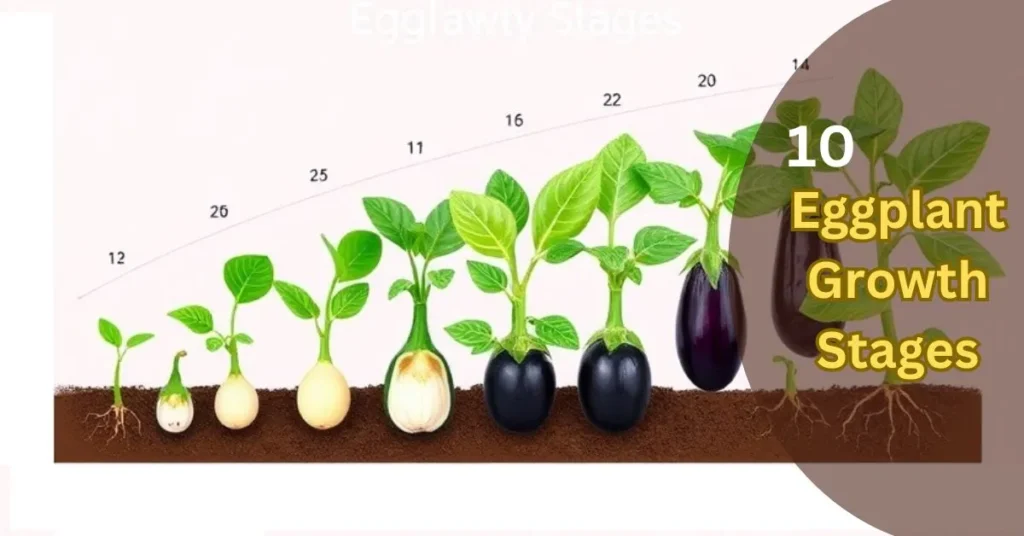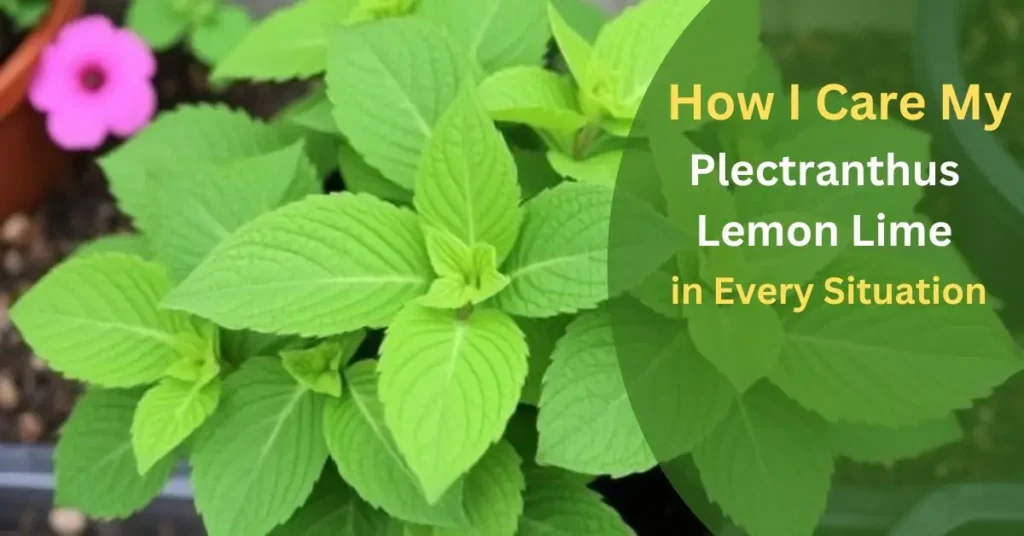Eggplant is an easy-to-grow warm-season crop that thrives in a garden plot, raised bed, or large container. To grow healthy plants, provide bright sunlight, warmth, and rich, moist, well-drained soil.
Depending on the variety, eggplants come in different shapes and sizes, like the long narrow types for stirfries or rounded white varieties perfect for baked eggplant boats.
As they grow, eggplants will develop in a range of colors—green, purple, and white—with each variety having its own uses. Whether for sauteed veggies, stir fry, or stuffed dishes, they reach their harvest-ready stage when fully mature. The care you provide will ensure a bountiful harvest, no matter the eggplant type.
10 Growth Stages of Eggplant Plants
| #- | Stage | Key Notes |
|---|---|---|
| 1- | Selecting Seeds | Start seeds indoors 8-9 weeks before the last frost, plant ¼-½ inch deep, 2-3 seeds per pot, keep warm and moist. |
| 2- | Sowing Seeds | Green shoot emerges above the soil, followed by tiny green leaflets, appearing 6-12 days after planting, lasting 2-3 weeks, keep warm and moist. |
| 3- | Germination | Seeds germinate in 5-10 days as the seed softens and opens, forming a tiny root. |
| 4- | Cotyledons | Cotyledons appear 7-14 days after sowing, marking the beginning of rapid growth, time to thin seedlings and transplant into the garden. |
| 5- | True Leaves | True leaves appear 7-14 days after cotyledons, with wavy edges, rough or tough texture, and continue rapid growth. |
| 6- | Vegetative Growth | Fast growth rate, larger leaves appear, watch for pests and diseases, consider companion planting, 1-2 inches of water per week. |
| 7- | Flowering | 60+ days after starting seeds, pale purple, star-shaped flowers bloom, attracting pollinators, time to fertilize. |
| 8- | Fruiting | Fruits start forming 7-14 days after flowering, becoming thick and fleshy. Keep watering and apply fertilizer again. |
| 9 | Harvest | 65-100 days from seed to harvest, ripe fruits feel firm with a slight give, cut stems to harvest, enjoy cooking with eggplant! |
| 10 | Root Development: | Eggplants grown from seed reach about 6 inches tall in 7 weeks, with a strong taproot that penetrates up to 3 feet, and horizontal branches spreading 12 to 18 inches across the soil surface |
Eggplant Growing Basics

Light
When it comes to growing eggplant, one of the most important factors is light. For good growth, eggplants require full daylight, which implies at least 6 hours of direct sunshine per day.
This exposure to sunlight is necessary to ensure strong plant development and proper growth. Insufficient light can hinder your plants’ ability to thrive. In ideal conditions, eggplants require even more hours of sunlight for the best results.
The sun provides the warmth and energy that the plant needs, so make sure to plant them in an outdoor space where they can get daily sunlight. Sunlight requirements are critical, and having long hours of sunlight each day will help your plants grow healthy and strong.
Temperature
For eggplants to grow successfully, they need hot temperatures. Eggplants thrive best in daytime temperatures ranging from 65°F to 95°F. These plants are sensitive to cold and will die if exposed to frost. It’s important to keep them in warmth for optimal growth. If temperatures drop below their heat tolerance, they won’t thrive.
The climate plays a big role in the plant’s survival. For eggplants to do well, make sure they’re planted in outdoor conditions where the temperature stays consistent and does not dip into frost-prone areas.
Cold-sensitive, eggplants won’t grow if exposed to frost risk, so always check the weather and ensure they are in the garden at the right time. Their survival depends on the right temperature and heat levels.
Soil type
When growing eggplants, choosing the right soil type is essential. The best soil for eggplants is rich, loamy, and well-drained. This type of soil provides the perfect conditions for growth by allowing the plant’s roots to spread easily while also retaining enough moisture. It should have good drainage to prevent waterlogging, which can harm the roots.
A balanced soil structure that is not too compact helps the plant develop properly. For your eggplant plants to thrive, they need soil that is full of essential nutrients and has a high fertility level.
The texture of the soil also plays a role in how well the plant will grow. For best results, make sure the soil in your garden is ready for planting by enriching it with organic matter to enhance its moisture retention and provide the necessary nutrients for healthy eggplant cultivation.
Soil moisture
Eggplants thrive when they have consistent soil moisture. It’s crucial to maintain the soil’s moisture without making it overly wet. Provide about 1 to 2 inches of water weekly to support optimal growth. Regular watering is necessary to meet the hydration needs of the plant, but be careful not to overwater, as this can lead to root rot.
During dry spells, a deep watering can help ensure the plant’s hydration is maintained. Keep an eye on the moisture levels in your garden and adjust your irrigation schedule as needed to provide the best environment for your eggplant. Proper water management is crucial for both growth and yield.
Soil pH
For eggplant growth, the ideal pH level of the soil should fall within the range of 6.0 to 7.0. This range ensures that the soil maintains the right balance of acidity and alkalinity, promoting the healthy growth of your plants. Maintaining the proper pH is crucial for nutrient availability, as it influences how well your eggplant can absorb essential nutrients.
You can test the soil’s pH with a simple testing kit and adjust it using fertilizer or soil amendments if necessary. This balance of acidity and alkalinity also creates a favorable environment for the cultivation of healthy plants, ultimately improving crop yield.
A well-balanced pH helps plants thrive in the garden, ensuring that the soil quality supports optimal growth and provides the right conditions for the eggplant to flourish. Regular soil testing will help you keep track of the pH balance and make timely adjustments to maintain the ideal environment for your plants.
Fertilizer
To ensure healthy growth of your eggplant plants, it’s important to fertilize them at the right times. Begin by using organic compost or vegetable gardening fertilizer that is rich in nutrients.
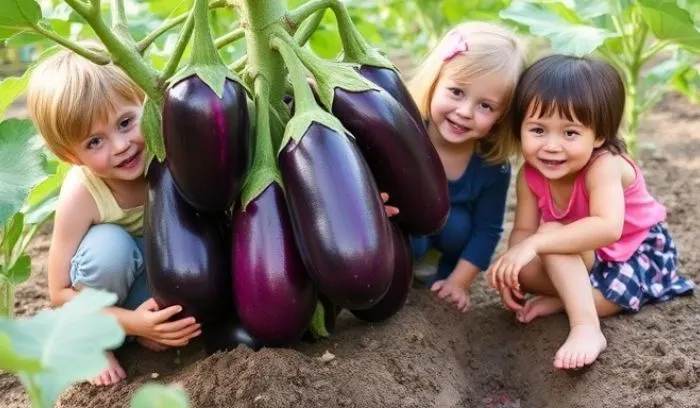
Applying fertilizer during the flowering and fruiting stages helps to provide the essential nutrients for continued development. Follow the directions on the package to avoid over or underfeeding, as improper application can hinder plant growth.
Make sure to apply the fertilizer at the proper timing for each stage of the growth cycle. During the flowering stage, it helps support the plant’s ability to produce strong flowers, and during the fruiting stage, it ensures the plants’ needs for larger, healthier fruits are met.
The right balance of organic matter and soil nutrients will promote the healthy development of your eggplant plants and boost their overall growth.
Weed and pest control
When growing eggplant, it’s important to manage weeds and pests to ensure healthy plants. Weeds can quickly take over the garden area, competing with your eggplant for nutrients and water. Regular weeds removal is crucial for maintaining a healthy growing environment.
Be mindful of pests, which can be challenging to control. Some larger pests can be easily managed by hand-picking them off the plants. For pests control, avoid using harsh chemical insecticides, as these can kill not only the harmful pests but also the beneficial insects that help protect your garden. Instead, focus on pest management methods like insects protection and natural solutions.
In addition to physical removal, you can improve your garden maintenance by encouraging natural predators and using organic treatments to prevent future infestations.
Effective weed and pest control is a combination of regular removal, insects protection, and avoiding harmful chemicals, helping your eggplant grow strong and healthy. The goal is to keep a balance in your garden to promote the growth of the plants while protecting the environment.
See Also: Why Are Seeds Popping Out of the Soil When Worms Fertilize?
Stage 1. Selecting Seeds
When choosing eggplant seeds, it’s essential to consider the variety that best suits your needs. Whether you’re growing for a meaty, large variety to make stuffed eggplant or a thin, Asian variety for frying, there is an assortment of options available.
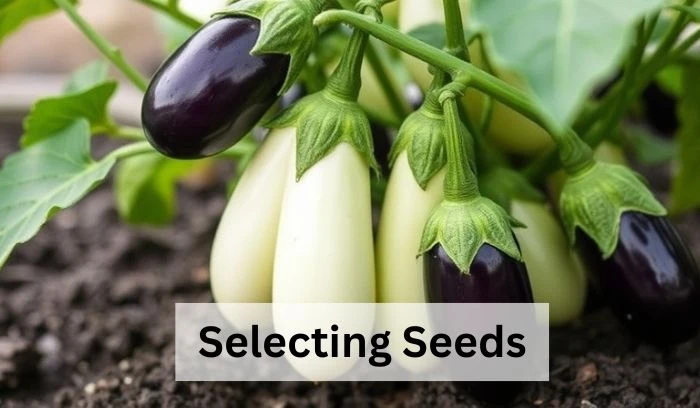
You can also opt for a unique and different shape, like the oval-shaped white eggplant, or explore the different shades of purple, green, and white. Each variety has similar growth requirements and follows the same stages of growth, so pick one that fits your cooking style.
Eggplant seeds are typically pale brown in color, small, and flat. They should remain viable for 4 to 6 years when stored in a cool, dry place. Over time, seed viability decreases, but even old seeds can still sprout. However, if your seeds seem moldy or have a musty smell, it’s better to buy fresh seeds to ensure healthy plant growth.
Stage 2. Sowing Seeds
When you decide to plant eggplants, it’s best to start seeds indoors to have more control over the temperature and soil moisture. Eggplants are a warm-season crop, so it’s important to begin the process 8 to 9 weeks before the last average spring frost date. If starting from seeds seems too challenging, you can always buy young plants from a garden center and transplant them once the frost danger has passed.
If you’re starting from seeds, use high-quality seed-starting pots. Sow 2 to 3 seeds in each pot, placing them ¼ to ½ inch deep into the soil. Be sure to moisten the soil and keep it warm by placing your pots in a sunny window or under a grow light.
For added warmth, use a heating mat to help with germination. Water the pots frequently, but make sure the soil stays moist and in the ideal temperature range of 65°F to 90°F to promote healthy seedlings. Keep an eye on them and provide the right seedling care as they grow.
Stage 3. Germination
Germination is a fascinating process where seeds begin to grow into new plants. For example, eggplant seeds typically germinate in about 5 to 10 days under ideal conditions.

As the tough outer layer of the seed softens, it cracks open, allowing the first sign of life to appear: the rootlet. This small root, which initially grows down into the soil, anchors the seed in place, making it ready to begin its journey.
The growth stage happens primarily underground, so it’s easy to miss the subtle changes that take place. But with patience, you’ll eventually see a tiny white root emerge and start to grow longer.
As the root stretches further, it forms branches, seeking moisture, nutrients, and anchor points in the soil. It’s important to keep the environment warm and moist during this time to ensure healthy growth.
After a few days, a green sprout will appear on the surface, marking the transition from root formation to the next stage, cotyledons. This tiny sprout signals the beginning of a plant’s life, as it starts to grow toward the light.
Stage 4. Cotyledons
After planting your seed, it won’t take long to see the first signs of life. In favorable conditions, within 6 to 12 days, the cotyledons will appear. These are the first seed leaves of the plant and often look quite different from the true leaves that will form later.
For example, eggplant cotyledons typically emerge as a pair of thin, pointed leaves, though sometimes you may see three leaves. These early leaves are tiny and delicate, playing a crucial role in the plant’s early development.
During this phase, the plant is still very sensitive. Both the stems and the cotyledons are tender and vulnerable to drying out, extreme sun, or cold. It’s essential to keep the plant in a warm and moist environment, checking on it frequently to ensure it doesn’t get too dry. The cotyledon stage lasts around 14 to 21 days, after which the first true leaves start to emerge, marking the next step in the plant’s growth.
See Also: When to Seed Lemongrass in Zone 9a? A Complete Guide
Stage 5. True Leaves
After the cotyledons have served their purpose, the true leaves begin to appear, usually within 7 to 14 days. In better conditions, your plant will start to develop more rapidly, and you will notice the true leaves forming. These leaves are the plant’s first real signs of growth, as they carry out photosynthesis and provide energy for further growth.
The first couple of true leaves will be small, but they will soon grow larger and more defined. For eggplant, the true leaves are typically oval-shaped with tapering tips. As the plant matures, the edges of these leaves become wavy, and their surface may feel fuzzy or rough.
Once your plant has a few true leaves, it’s time to start thinning. If you have multiple seedlings in the same pot, remove the weaker ones by using sharp scissors to snip the stems. Avoid pulling them out by the roots to prevent disturbing the growth of the remaining plant. This careful cultivation ensures that the seedling has the space and resources needed to grow strong and healthy.
Transplanting Young Plants
When your young plants reach about 5 inches tall and the threat of frost has passed, it’s time to prepare them for transplanting outdoors. Begin by hardening them off, a process that helps the plants adjust to outdoor conditions.
Start by placing them outside in a protected location, where they can experience limited exposure to bright sunlight. Over the course of a week, gradually increase their exposure to sunshine. Bring them indoors at night if the temperature falls below 55°F. This will help them grow stronger and more resilient to the elements.
Your plants should be ready for planting after a week of hardening off. If you’re transplanting eggplants, they thrive in hot weather, so wait until daytime temperatures reach 70°F before moving them outside.
Dig a hole in the site with rich, fertile, and well-drained soil. Carefully transfer the plants into the hole, ensuring they have enough space—about 18 inches apart—to grow properly. Whether you choose to plant them in a raised bed, container, or traditional garden rows, your plants will soon begin to thrive in their new home.
Stage 6. Vegetative Growth
Once your young plants have developed true leaves, they will begin a phase of rapid vegetative growth. During this stage, the roots grow deep into the surface, and the plant starts producing new leaves to support its future flowering and fruit development.

The green leaves are vital as they absorb sunlight, water, and carbon dioxide, using these to power photosynthesis and create the sugar energy needed for growth. This process also releases oxygen, which is essential for the environment.
For healthy growth, make sure the eggplants are in a location with full sun, receiving six hours or more of direct sunlight every day. Keep the soil moist, ensuring they receive 1 to 2 inches of water each week.
If rainfall isn’t enough, do supplemental watering around the base of the plants to give them a deep drink. Applying organic mulch around the plants can help maintain soil moisture and protect against insect pests, which can cause damage to the plants. Keep an eye out for signs like holes, thin, veiny leaves, or wilting and leaf curling, as these indicate potential pest problems.
Pests and diseases
Small Black Beetles and Potato Beetles
One of the biggest challenges in growing plants like eggplants is dealing with pests and diseases. Small black beetles are a common pest that chews holes in leaves, especially on seedlings and young plants. These beetles can cause significant damage, and while older plants might be tolerant, they still suffer.
Potato beetles, which are medium-sized and have orange, white, and black-striped bodies, also attack eggplant and potato leaves. Their larvae, which are soft-bodied and bright orange with black spots, feed on the edges of leaves. These pests are difficult to control, but you can handpick them and place them in soapy water.
Hornworms and Stinkbugs
In addition to the beetles, hornworms are another pest that can damage plants. These large green caterpillars feed voraciously on tomatoes and eggplants, quickly consuming leaves and causing the plant to defoliate.
These caterpillars are harmless to humans, and the best way to manage them is to remove them by hand. Stinkbugs, which are large insects with sucking mouthparts, also harm your plants by sucking juices from leaves.
This causes dead brown spots to appear on leaves and fruits, further stressing the plant. Removing them by hand or dropping them in soapy water can help control their population.
Diseases: Blight and Bacterial Wilt
When it comes to diseases, blight is a fungal infection that can cause severe wilting of the plant. It results in blackened leaves, stems, and fruits, often killing the plant if left unchecked.
To prevent blight, it’s important to avoid letting your plants sit in wet soil and practice crop rotation. Another disease to watch out for is bacterial wilt, which causes sudden wilting and death of the plant. Affected parts, like leaves, stems, and fruits, will turn brown and eventually die. Rotating crops and avoiding planting eggplants, tomatoes, or potatoes in the same location for successive years can reduce the risk of this disease.
Using Pesticides Sparingly
While it may be tempting to use broad-spectrum insecticide to manage pests, it’s essential to use them sparingly to avoid harming beneficial insects. These beneficial insects are vital for pollination. If you must use a pesticide, apply it in the late evening when pollinators are less active. This helps protect them while still controlling harmful pests.
Tips for a Healthy Crop
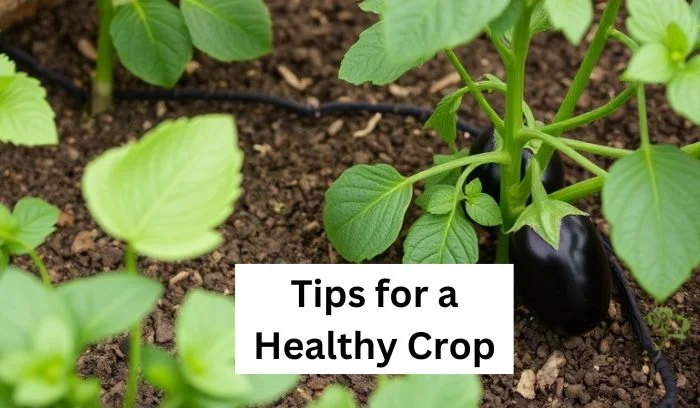
Crop rotation
To keep your garden healthy, it’s important not to grow eggplants, tomatoes, or potatoes in the same place for two years in a row. These crops attract many of the same pests, which can build up in the soil over time.
By choosing to rotate them with other crops, you can help discourage repeated infestations. This practice not only reduces pest problems but also gives your soil a chance to recover, keeping your crops strong and healthy year after year.
I’ve found that changing things up each season can lead to better growth, as pests don’t have a chance to settle in one place. By rotating your crops, you’re not just preventing pests; you’re also promoting better soil health and helping your plants thrive in a more natural environment.
Soil moisture
Maintaining soil moisture is key to growing a healthy crop, especially when it comes to eggplants. These plants thrive in consistently moist soil, but you need to avoid wet soil. It’s essential to keep an eye on the moisture levels and make sure the soil doesn’t become too soggy, as that could lead to root rot.
Watering regularly ensures that the plants receive about 1 to 2 inches of water per week. This helps the eggplants stay hydrated without sitting in wet conditions, promoting stronger growth and better yields.
When you water your plants, aim to keep the soil moist, but not soaking. Consistency is important to help the plants establish strong roots. A steady moisture level allows the eggplants to grow healthily and avoid stress, ensuring a successful crop.
Following these tips and paying attention to the moisture will lead to vibrant, thriving plants. With the right care, your crop can flourish and produce plenty of eggplants for your harvest.
Be proactive
To maintain a healthy crop, it’s important to check plants regularly for any signs of illness or disease. Early detection is key, as it allows you to take appropriate steps to correct the issue before it gets worse.
By addressing problems quickly, you can prevent them from spreading to nearby plants and avoid larger, more complicated issues down the line. Over the years, I’ve found that keeping a close eye on your garden can make all the difference, especially when you catch small problems before they escalate.
Being proactive in your gardening routine ensures the health of your crops. If you notice any unusual changes, act quickly to stop the spread of disease or illness. The earlier you address the problem, the better your plants will recover and thrive.
It’s always easier to manage small issues before they turn into bigger ones, so don’t wait for things to get out of hand. With consistent attention and action, your plants will stay healthy and productive.
Keep area clean
A clean garden is the first step to a healthy crop. Regularly clean up debris and remove any dead plant matter to prevent harmful conditions. Insects and pests often find shelter in leafy debris, while slugs are known to hide in damp areas, causing damage to your plants. Keeping the area free of clutter helps maintain a balanced environment for growth.
From personal experience, staying proactive pays off. When I removed hidden debris and matter, my crops thrived better than before. By ensuring pests have fewer places to hide, you can focus on nurturing the plants rather than battling infestations. Make cleaning a regular part of your gardening routine to protect the crops you’ve worked so hard to grow.
Companion Plants
Companion planting is a great way to help your garden plants thrive. By pairing different species that naturally work well together, you create a supportive environment where plants can benefit each other. Some companion plants can provide support, offer shade, or even enhance soil with nutrients.
For example, beans are excellent for enriching the soil, while borage attracts vital pollinators. This practice doesn’t just help plants grow better but also strengthens your garden’s overall health.
If pests like to bother your eggplants, you can place pest-deterrent plants such as marigold, oregano, or kohlrabi nearby. These plants help repel pests, making your garden more productive.
The combination of these thoughtful placements and plant choices ensures your garden remains balanced and vibrant. Whether you’re new to gardening or experienced, practicing companion planting is a smart, natural way to boost success.
See Also: How to Grow Plants Along a Vinyl Fence: Step-by-Step Guide
Stage 7. Flowering
An eggplant starts flowering about 60 days after seeding, showing it’s reaching maturity and ready to produce fruits. Its pale purple, star-shaped flowers are self-fertile, meaning even a single plant can bear fruit.
However, planting another nearby eggplant helps cross-pollination, often leading to a better yield. Watching the beginnings of the first fruits on healthy plants before the first frost is truly rewarding.
To support these heavy feeders, add rich organic compost to the sides of the plant during its growing season and carefully work it into the soil. A general-purpose vegetable gardening fertilizer also provides great benefit, but follow the directions on the package to avoid over-fertilizing, which causes excessive leaves at the detriment of fruit production.
Stage 8. Fruiting
Once the flowers bloom, the process of developing fruits begins. In about a week or two, the fruits will start growing but they shouldn’t be left to grow as large as possible.
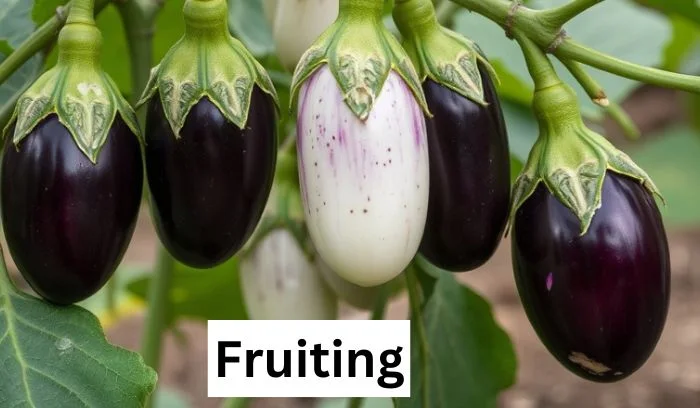
Young fruits are the most tender and sweet, while older fruits tend to be bitter and have larger, tougher seeds. As the fruits mature, you’ll see the shape and size vary. Eggplants come in different colors, including white, pale lilac, and deep purplish-black, with some resembling eggs and others being oblong or longer.
There are also smaller green orbs and a variety of other shapes and sizes. Some eggplants have thick, meaty fruits, while others are long and slender.
As the fruits grow, they may display a combination of purple and white, all depending on the variety. It’s exciting to watch as they grow and reach their peak, signaling that it’s almost time for the harvest.
Stage 9. Harvest
After about 65 to 100 days from sowing the seed, the time for your first harvest will arrive. The timing depends on your eggplant variety and growing conditions, so some guesswork might be needed.Fruits are usually ready for harvest when they appear fully ripe. A ripe fruit will have smooth, firm skin with a slight give when you press it.
On the other hand, old fruits will become soft, wrinkly, and might show brown spots, indicating they are overripe or possibly diseased. Inside, tender seeds that are white or off-white suggest the fruit is ripe, while larger, darker seeds signal the fruit is past its prime.
To harvest your eggplant, hold the fruit gently and use sharp scissors or pruning shears to snip the stem just above the fruit. Avoid trying to pull or twist the fruit, as this could damage the plant. After harvest, store your eggplants in the crisper drawer of your refrigerator for 1 to 2 weeks.
You can enjoy your eggplant feast in various ways, but remember that while raw eggplants are edible, they are quite bitter. It’s best to cook them—whether you bake, sautee, roast, grill, or even mash them into a creamy baba ganoush. Eggplant is a versatile vegetable that can bring a lot of flavor to your meals.
Stage 10. Root Development
When eggplants are grown from seed, they start small, measuring about 6 inches tall after 7 weeks. At this point, the strong taproot begins to grow, penetrating deep into the soil and reaching depths of up to three feet.
As the plant matures, horizontal branches emerge and spread across the surface of the soil, typically extending between 12 to 18 inches. This growth pattern helps the plant establish a solid foundation, allowing it to absorb nutrients and water efficiently from the surface and deeper soil layers. Ensuring the right conditions for root growth is crucial for the healthy development of the eggplant.
Eggplant growth stages in pots
When growing eggplant in pots, the key is to choose the right container gardening setup. A pot should be at least 30 cm (about 12 inches) in diameter and depth with drainage holes to avoid waterlogging.
Using a well-draining potting mix, such as a combination of compost, garden soil, and perlite, is essential for healthy growth. Starting with seedlings from a nursery or sowing seeds directly into the pot will determine how quickly your plant starts. Be sure to follow the planting depth and spacing instructions on the seed packet.
As the eggplant grows, support is necessary. Install a stake or trellis system for support, especially for compact or dwarf varieties that may need help with staking and trellising. Place your pot in a sunny spot, ensuring it gets at least 6-8 hours of direct sunlight each day. Keep the potting mix evenly moist, but check the moisture level with your finger to avoid overwatering.
Eggplants are heavy feeders, so be sure to fertilise regularly with a balanced fertiliser or organic fertilisers like fish emulsion. If pests like aphids, flea beetles, or spider mites show up, use insecticidal soap or organic insecticides to protect your plant. Once your eggplant reaches its mature size, it will have a glossy, firm texture, signaling it’s ready for harvest. Use a sharp knife or pruning shears to carefully cut the eggplants, and enjoy them fresh right at your doorstep!
How many eggplants will one plant produce?
Eggplants flourish in warm climates but might be destroyed by chilly temperatures. A healthy plant, when well watered and properly cared for, can produce anywhere from 4 to 6 large fruit. If the fruit is harvested regularly, the plant may continue to grow and yield even more. Ensuring optimal growing conditions, such as proper watering and protection from the cold, helps maximize the harvest.
In my experience, plants that are regularly tended to and protected from cold damage tend to give better yields, sometimes exceeding the typical range of 4 to 6 fruits. Harvested fruits encourage more growth, and providing consistent care results in a thriving plant. Keep an eye on your plant, as the right care will help it produce to its full potential.
The Benefits of Growing Your Own Eggplant at Home
Cultivating eggplants at home can be a fulfilling and enjoyable experience. As a Cajun in a family where eggplant was a summer staple, it was part of our garden and cuisine alongside squash, okra, and tomatoes. I remember eating ratatouille, a dish full of these vegetables, all the time.
Over the years, I came to appreciate the benefits of having eggplant right from your garden, especially knowing it’s packed with antioxidants that protect our cells from damage. It’s also great for people with diabetes, as it helps them process sugar more easily.
One of the biggest advantages of growing your own eggplant is the ability to experiment with different varieties. I didn’t truly love eggplant until adulthood, when I tried the buttery, delicious Chinese eggplant in a stir fry.
Now, I’m absolutely head over heels for this purple vegetable and the goodness it brings. By growing eggplant at home, you get to enjoy fresh, healthy eggplant while trying new varieties and reaping all the health benefits.
Eggplant Diseases
Eggplants are prone to several diseases that can harm their growth and overall health. Common issues include Verticillium Wilt, Fusarium Wilt, and Bacterial Wilt, all of which can cause wilting, yellowing leaves, and eventually plant death.

These fungal diseases, caused by pathogens like Fusarium oxysporum and Verticillium dahliae, infect the plant’s vascular system, disrupting nutrient flow. Effective crop rotation and using resistant varieties can help reduce the risk.
Additionally, Phytophthora Blight, caused by the Phytophthora fungus, can lead to water-soaked lesions and rotting, further contributing to plant decline. Maintaining proper sanitation practices, soil moisture levels, and avoiding overwatering are key steps in prevention.
Another significant concern for eggplant health is Powdery Mildew, which appears as a white, powdery growth on leaves and stems, weakening the plant.This disease can be avoided by maintaining good air circulation and avoiding overhead watering. Anthracnose is commonly found, characterized by dark, sunken lesions on the fruit.
Managing these diseases requires monitoring plants regularly for signs of disease, maintaining optimal growing conditions, and using fungicides when necessary. Consistent attention to sanitation and drainage helps prevent the spread of these diseases, ensuring healthier eggplants.
What Is The Lifespan Of An Eggplant?
Eggplants are annual plants, completing their life cycle within a single year. They thrive in a long, warm growing season, typically from spring to fall. These plants need plenty of warmth to grow and produce their fruit. By the end of the growing season, they complete their cycle and die off, making way for new plants in the next year.
In my experience, eggplants are best suited to regions with consistently warm temperatures. A long, sunny growing season is essential for the plants to develop fully and produce the best yields.
Eggplant Growth Stages: Dos and Don’ts
| Recommended Actions | Things to Avoid |
|---|---|
| Water regularly to maintain moist soil. | Avoid overwatering, which can cause root rot. |
| Provide extra nutrition during flowering and fruiting. | Skip proper nutrition, leading to poor growth. |
| Place plants in a sunny and warm location. | Avoid planting in shady or cold areas. |
| Use a raised bed or container for limited space. | Avoid planting in overly small pots or containers. |
| Manage pests and diseases before they spread. | Ignore early signs of pests or diseases. |
| Take care of the plant by removing dead leaves. | Leave damaged parts of the plant unattended. |
| Keep the soil moist, but not soggy. | Let the soil dry out completely. |
| Ensure plants have enough space to grow. | Overcrowd the plants in small spaces. |
| Harvest eggplants when ripe. | Wait too long to harvest, leading to bitterness. |
FAQs
For healthy eggplants, a balanced fertilizer like 10-10-10 is recommended. Avoid too much nitrogen, as it can cause large, leafy plants without fruit. This balanced approach helps your plants grow and produce the best harvest.
Eggplants grow best when soil temperatures are in the 70s and 80s. If the soil temperature dips to 60, it sends a signal to the plant to conserve energy. The plant gets afraid that it might die due to cold weather. As a result, it stops growing and may drop seeds from the fruit. These seeds won’t germinate properly in the cooler weather, causing slow growth. The plant’s natural reaction is to protect itself, which is why eggplants may grow more slowly when temperatures aren’t ideal.
To protect young eggplant seedlings, apply mulch around them. This will protect the roots and help keep the soil’s nutrients intact, promoting healthy growth. Mulch also helps retain moisture and shields the plants from temperature changes.
Using a trellis for support is an excellent choice when growing eggplants. It helps prevent the fruit from touching the ground, reducing the risk of diseases and damage. The trellis keeps the plant upright, allowing it to grow better and healthier.
Final Thoughts
As you continue your journey with eggplant, the growth stages of this plant will require consistent attention and care. Whether you are planting in a raised bed, a large container, or even a garden, the key to successful eggplant cultivation is ensuring a sunny, moist, and warm location.
Throughout the growing process, watering regularly and providing the right nutrition is crucial, especially during the flowering and fruiting stages. Extra nutrition will help your plants produce delicious and nutritious fruits.
To maintain healthy growth, it’s essential to manage any potential pests and diseases before they can affect your plants. Being proactive with pest management and controlling issues early will ensure your home-grown produce thrives. By taking care of your plants, you will enjoy growing tasty and full-size eggplants.
The satisfaction of harvesting eggplant from your own garden or container is unparalleled, especially when you can turn them into amazing dishes. Make sure to give your plants the right attention and control the factors that influence their health for a successful harvest.

